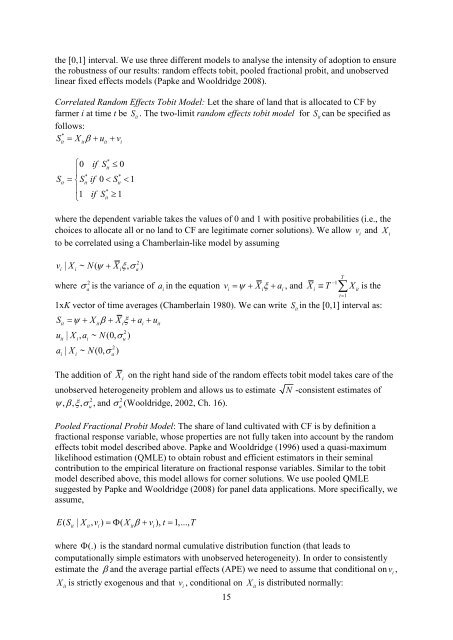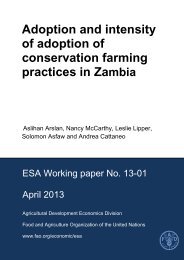Adoption and intensity of adoption of conservation farming practices in Zambia
Adoption and intensity of adoption of conservation farming practices in Zambia
Adoption and intensity of adoption of conservation farming practices in Zambia
You also want an ePaper? Increase the reach of your titles
YUMPU automatically turns print PDFs into web optimized ePapers that Google loves.
the [0,1] <strong>in</strong>terval. We use three different models to analyse the <strong><strong>in</strong>tensity</strong> <strong>of</strong> <strong>adoption</strong> to ensure<br />
the robustness <strong>of</strong> our results: r<strong>and</strong>om effects tobit, pooled fractional probit, <strong>and</strong> unobserved<br />
l<strong>in</strong>ear fixed effects models (Papke <strong>and</strong> Wooldridge 2008).<br />
Correlated R<strong>and</strong>om Effects Tobit Model: Let the share <strong>of</strong> l<strong>and</strong> that is allocated to CF by<br />
farmer i at time t be it S . The two-limit r<strong>and</strong>om effects tobit model for Sit can be specified as<br />
follows:<br />
*<br />
S = X β + u + v<br />
it it it i<br />
⎧ ≤<br />
*<br />
0 if Sit<br />
0<br />
⎪ * *<br />
it ⎨ it it<br />
⎪<br />
*<br />
1 if Sit<br />
≥ 1<br />
S = S if 0< S < 1<br />
⎩<br />
where the dependent variable takes the values <strong>of</strong> 0 <strong>and</strong> 1 with positive probabilities (i.e., the<br />
choices to allocate all or no l<strong>and</strong> to CF are legitimate corner solutions). We allow i v <strong>and</strong> i X<br />
to be correlated us<strong>in</strong>g a Chamberla<strong>in</strong>-like model by assum<strong>in</strong>g<br />
v X N X<br />
2<br />
i | i ~ ( ψ+ iξσ , a)<br />
where<br />
2<br />
σ a is the variance <strong>of</strong> i<br />
T<br />
−1<br />
i it<br />
t=<br />
1<br />
a <strong>in</strong> the equation vi = ψ + Xiξ + ai,<br />
<strong>and</strong> X ≡ T ∑ X is the<br />
1xK vector <strong>of</strong> time averages (Chamberla<strong>in</strong> 1980). We can write Sit <strong>in</strong> the [0,1] <strong>in</strong>terval as:<br />
S = ψ + X β + X ξ + a + u<br />
it it i i it<br />
it | i, i ~<br />
2<br />
(0, σ u )<br />
i | i ~<br />
2<br />
(0, σ a)<br />
u X a N<br />
a X N<br />
The addition <strong>of</strong> X i on the right h<strong>and</strong> side <strong>of</strong> the r<strong>and</strong>om effects tobit model takes care <strong>of</strong> the<br />
unobserved heterogeneity problem <strong>and</strong> allows us to estimate N -consistent estimates <strong>of</strong><br />
2 2<br />
ψ, βξσ , , , <strong>and</strong> σ (Wooldridge, 2002, Ch. 16).<br />
u a<br />
Pooled Fractional Probit Model: The share <strong>of</strong> l<strong>and</strong> cultivated with CF is by def<strong>in</strong>ition a<br />
fractional response variable, whose properties are not fully taken <strong>in</strong>to account by the r<strong>and</strong>om<br />
effects tobit model described above. Papke <strong>and</strong> Wooldridge (1996) used a quasi-maximum<br />
likelihood estimation (QMLE) to obta<strong>in</strong> robust <strong>and</strong> efficient estimators <strong>in</strong> their sem<strong>in</strong>al<br />
contribution to the empirical literature on fractional response variables. Similar to the tobit<br />
model described above, this model allows for corner solutions. We use pooled QMLE<br />
suggested by Papke <strong>and</strong> Wooldridge (2008) for panel data applications. More specifically, we<br />
assume,<br />
ES ( | X, v) =Φ ( Xβ + v), t= 1,..., T<br />
it it i it i<br />
where Φ (.) is the st<strong>and</strong>ard normal cumulative distribution function (that leads to<br />
computationally simple estimators with unobserved heterogeneity). In order to consistently<br />
estimate the β <strong>and</strong> the average partial effects (APE) we need to assume that conditional on v i ,<br />
X it is strictly exogenous <strong>and</strong> that i<br />
15<br />
v , conditional on X it is distributed normally:



